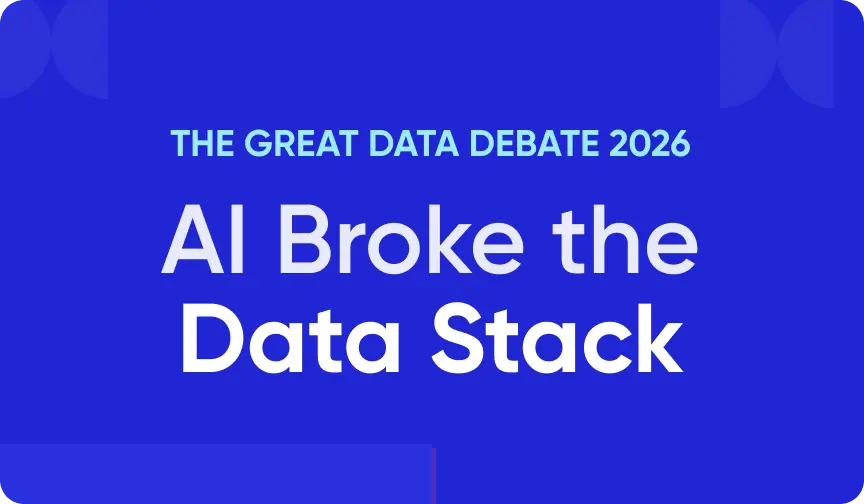9 Data Quality Issues in 2025 & 7 Ways to Assess Them
Share this article
Quick Answer: What are data quality issues?
Permalink to “Quick Answer: What are data quality issues?”Data quality issues are problems that compromise the reliability, accuracy, or usability of data. The nine most common data quality issues are:
- Inaccurate data entry
- Incomplete data
- Duplicate entries
- Volume overwhelm and overload
- Variety in schema and format
- Veracity and data accuracy
- Velocity and real-time ingestion issues
- Low-value or irrelevant data
- Lack of data governance
Up next, we will explore these common data quality issues in detail, how to fix them, and factors affecting the data quality.
Table of contents
Permalink to “Table of contents”- Data quality issues explained
- What are the nine most common data quality issues?
- What are the key factors affecting data quality?
- How can you assess data quality issues in 7 easy steps?
- Data quality issues: Final thoughts
- Data quality issues: Frequently asked questions (FAQs)
- Data quality issues: Related reads
Data quality issues explained
Permalink to “Data quality issues explained”Data quality issues are imperfections in your data’s structure, content, or context that stop it from being truly useful. Whether you’re aiming to understand your customers better, predict future sales, or meet strict industry rules, bad data quality will hinder your progress and can even send you down the wrong path.
These issues often arise from a variety of sources:
- Missing or outdated metadata: Without proper information about your data, it’s tough to check its validity or understand its origin.
- Weak governance: A lack of clear rules for how data is created, changed, and used opens the door to errors and inconsistencies.
- Siloed systems: When different systems don’t talk to each other, or lack integrated quality checks, data problems can easily spread unchecked.
- Manual, error-prone processes: Relying on people to manually handle data without automation or clear accountability significantly increases the chance of mistakes.
Tackling these challenges requires a comprehensive, strategic approach that leverages data about your data (metadata). This includes:
- Establishing clear data governance policies: Setting firm rules for data handling ensures consistency and accountability.
- Deploying advanced data cleaning tools: Using specialized software can automatically identify and fix common data flaws.
- Implementing continuous quality audits and monitoring: Regularly checking your data for problems helps catch issues before they become major headaches.
- Developing context-aware remediation workflows: Fixing data problems effectively means understanding why they occurred and addressing the root cause, not just the symptom.
- Cultivating a culture of data responsibility: Everyone in the organization needs to understand the importance of good data and their role in maintaining it.
By taking these steps, you can ensure your data is as accurate, complete, consistent, reliable, relevant, timely, usable, and integral as possible. This, in turn, boosts its overall value and effectiveness for whatever purpose you need it for.
Next, let’s look at some specific, common data quality issues.
What are the nine most common data quality issues?
Permalink to “What are the nine most common data quality issues?”Let’s delve into the key data quality issues that often plague various industries, including banking, healthcare, and big data:
- Inaccurate data entry
- Incomplete data
- Duplicate entries
- Volume overwhelm and overload
- Variety in schema and format
- Veracity and data accuracy
- Velocity and real-time ingestion issues
- Low-value or irrelevant data
- Lack of data governance
Let’s understand each issue in detail.
1. Inaccurate data entry
Permalink to “1. Inaccurate data entry”Inaccurate data entry is a pervasive issue stemming from human errors during manual data input. These errors can range from simple typos and incorrect values to using the wrong units of measurement. They can creep in through forms, spreadsheets, or legacy system integrations.
For instance, in the banking sector, a mistyped interest rate can lead to inaccurate calculations, affecting loan and investment decisions. In healthcare, entering incorrect patient information can result in treatment errors and patient safety concerns.
2. Incomplete data
Permalink to “2. Incomplete data”Incomplete data occurs when essential information is missing from datasets. Incomplete records result in broken workflows, incomplete analysis, and poor customer experience.
In the healthcare industry, incomplete patient records can hinder accurate medical assessments, diagnoses, and treatment plans.
Incomplete financial transaction records can lead to gaps in banking analysis, impeding fraud detection and risk assessment.
3. Duplicate entries
Permalink to “3. Duplicate entries”Duplicate entries arise when the same data is recorded more than once, either due to system errors or human oversight. This issue can inflate data volume, consume storage resources, and create confusion during analysis.
In the context of banking, duplicate records might lead to inaccurate customer account balances or erroneous transaction histories.
In healthcare, duplicate patient records can result in unnecessary procedures and treatments. Implementing validation rules and automated checks can help identify and prevent duplicate entries.
4. Volume overwhelm and overload
Permalink to “4. Volume overwhelm and overload”The sheer volume of data can lead to challenges in data storage, management, and processing. Unfiltered data influx risks diluting meaningful insights, while storage constraints can compromise data accessibility and analytical capabilities.
In banking, transaction data from mobile apps or third-party platforms can pile up faster than systems can process, resulting in bottlenecks or missed anomalies.
In healthcare, continuous streams from IoT devices and EHRs can overload systems, making it hard to detect errors or track changes in real time.
5. Variety in schema and format
Permalink to “5. Variety in schema and format”Data comes in many shapes—structured, semi-structured, and unstructured—from diverse sources like APIs, forms, logs, and images. Without standardization, mismatches in schema or formatting cause integration failures and corrupt downstream analysis.
In banking, customer data collected from apps, websites, and in-person visits may use different formats for the same fields (e.g., date formats, currency values).
In healthcare, lab results and imaging files often come in incompatible formats, which slows interoperability between systems and compromises patient care.
6. Veracity and data accuracy
Permalink to “6. Veracity and data accuracy”Veracity refers to the trustworthiness of data. Low-veracity data may be technically correct in format but wrong in meaning, origin, or context—leading to misleading insights.
In banking, a dataset may indicate a transaction occurred, but if the timestamp is wrong or the currency field was misclassified, analysis will be flawed.
In healthcare, data pulled from unreliable external sources (outdated clinical studies, for instance) may appear valid but undermine evidence-based treatment decisions.
7. Velocity and real-time ingestion issues
Permalink to “7. Velocity and real-time ingestion issues”Organizations increasingly rely on real-time data, but inconsistent or delayed ingestion pipelines can introduce lags, partial data, or even drop events entirely.
In banking, a lag in fraud detection data can delay alerts, exposing customers and institutions to greater risk.
In healthcare, delays in real-time monitoring data (heart rate sensors, for instance) can impede urgent interventions. These issues are especially critical for systems where seconds matter.
8. Low-value or irrelevant data
Permalink to “8. Low-value or irrelevant data”Not all collected data adds business value. Data clutter—redundant, outdated, or irrelevant information—makes it harder to find actionable insights.
Relying on low-value, irrelevant, or outdated data is costly and can lead to misguided decisions.
In the banking sector, using outdated market trends can result in suboptimal investment strategies. In healthcare, excessive logging of device events without clinical relevance can inflate storage costs and slow down system performance.
9. Lack of scalable data governance
Permalink to “9. Lack of scalable data governance”A lack of data governance encompasses unclear ownership, standards, and scalable protocols for data management. In the banking sector, this can result in inconsistent customer information across different touchpoints, leading to a fragmented customer experience.
In the healthcare sector, inadequate data governance can hamper data sharing among different medical departments, hindering holistic patient care. Establishing data ownership, defining data quality standards, and implementing data stewardship practices are essential to ensure data integrity and consistency.
What are the key factors affecting data quality?
Permalink to “What are the key factors affecting data quality?”Here are the most common factors affecting data quality:
- Lack of metadata context: Data assets are undefined, lacking lineage and ownership, making quality assessment difficult.
- Inconsistent data standards: Differing definitions across teams lead to fragmented and untrustworthy data.
- Poor data governance: Absence of policies and accountability results in unresolved data inconsistencies.
- Data integration errors: Schema mismatches and data loss occur during data movement or merging.
- Unreliable data sources: Unverified third-party or scraped data introduces inaccuracies.
- Human error: Manual entry mistakes like typos and misclassifications are a common source of bad data.
- Data decay: Even high-quality data becomes misleading or obsolete over time.
- Siloed systems: Lack of shared access leads to replicated efforts, misinterpretations, and inconsistent data.
- Lack of clear data ownership: No designated stewards means no one is accountable for data quality.
How can you assess data quality issues in 7 easy steps?
Permalink to “How can you assess data quality issues in 7 easy steps?”Assessing data quality issues is the first step toward improving the reliability, usability, and trustworthiness of your data. Without a clear view of where problems exist, data teams often waste time firefighting rather than fixing root causes.
Here are seven effective ways to assess data quality issues:
- Data auditing: Data auditing involves evaluating datasets to identify anomalies, policy violations, and deviations from expected standards. It helps surface undocumented transformations, outdated records, or access issues that degrade quality.
- Data profiling: Profiling analyzes the structure, content, and relationships in data. It highlights distributions, outliers, nulls, and duplicates—giving you a quick snapshot of health across key fields.
- Data validation and cleansing: Validation checks that incoming data complies with predefined rules or constraints (e.g., date format, numeric ranges). Cleansing involves correcting or removing inaccurate or incomplete data.
- Comparing data from multiple sources: Cross-system comparisons can reveal discrepancies in fields that should be consistent—like customer addresses or transaction amounts across billing and CRM platforms. These checks expose silent integrity issues.
- Monitoring data quality metrics: Tracking metrics like completeness, uniqueness, and timeliness over time helps quantify where quality is breaking down—and whether your fixes are working. Dashboards and alerts provide visibility for data teams and business users alike.
- User feedback and domain expert involvement: End users often spot quality issues that automated tools miss. Business users and subject matter experts bring critical context and can flag gaps between what the data says and what’s actually true.
- Leveraging metadata for context: Metadata gives essential context for interpreting quality issues—like when a record was last updated, where it came from, and who owns it. Lineage, field definitions, and access logs help trace problems to their source and identify the right person to fix them.
How can a data quality studio like Atlan help reduce data quality issues?
Permalink to “How can a data quality studio like Atlan help reduce data quality issues?”A modern data quality studio like Atlan integrates with your metadata, pipelines, and quality tools to provide a single control plane for data health. This allows you to:
- Define, automate, and monitor rules that mirror real-world, business-defined expectations
- Monitor quality metrics across tools like Soda or Great Expectations
- Set rules for validation and alerting
- Route issues to the right owners via Slack or Jira
- Track coverage, visualize failures, and gauge business impact from a single dashboard
Such a metadata-first approach ensures that quality assessments are not siloed, but embedded across your data ecosystem. This, in turn, empowers business and data teams to collaborate in one workspace to keep analytics and AI running on purpose-built, trustworthy data.
Data quality issues: Final thoughts
Permalink to “Data quality issues: Final thoughts”Data quality issues directly impact business decisions and operational efficiency.
From inaccurate decisions to failed audits, the cost of poor-quality data compounds quickly across operations, analytics, and compliance. As data volumes grow and systems become more interconnected, addressing these issues requires more than one-off fixes.
By combining proactive governance with metadata-driven context and automation, organizations can prevent data issues before they arise, route them to the right teams when they do, and track improvements over time.
Data quality issues: Frequently asked questions (FAQs)
Permalink to “Data quality issues: Frequently asked questions (FAQs)”1. What are the most common data quality issues?
Permalink to “1. What are the most common data quality issues?”The most common data quality issues include inaccurate data entry, incomplete data, duplicate entries, challenges with data volume, variety in schema and format, low data veracity, real-time ingestion problems (velocity), irrelevant data, and a fundamental lack of scalable data governance.
These problems hinder data’s usability and reliability across various business functions and industries.
2. How do data quality issues impact businesses?
Permalink to “2. How do data quality issues impact businesses?”Data quality issues lead to faulty decisions, broken workflows, customer churn, and non-compliance with regulations—impacting everything from revenue to reputation.
3. Can data quality issues be fully eliminated?
Permalink to “3. Can data quality issues be fully eliminated?”While it’s challenging to achieve 100% perfect data, data quality issues can be significantly minimized and managed.
Data is constantly changing, and new issues can emerge. The goal is continuous improvement through ongoing monitoring, proactive cleaning, robust validation, and adaptive governance, creating a sustainable data quality management program rather than a one-time fix.
4. Can data quality be fully automated?
Permalink to “4. Can data quality be fully automated?”Automation can handle monitoring, validation, and rule enforcement, but human judgment is still essential—especially for domain-specific exceptions or gray areas.
5. How often should data quality be assessed?
Permalink to “5. How often should data quality be assessed?”Data quality should be assessed continuously and regularly, not just as a one-off project. Given the dynamic nature of data and business needs, implementing continuous quality audits and monitoring is essential.
This allows organizations to proactively detect emerging data quality issues, measure improvements over time, and ensure data remains fit for its intended purpose.
6. What role does metadata play in addressing data quality issues?
Permalink to “6. What role does metadata play in addressing data quality issues?”Metadata, or “data about data,” is crucial for addressing data quality issues. It provides context, lineage, definitions, and ownership information, which helps in validating data, understanding its origins, and tracing problems to their source. Leveraging metadata enables more effective data quality assessment, monitoring, and remediation workflows.
7. How does data governance help mitigate data quality issues?
Permalink to “7. How does data governance help mitigate data quality issues?”Data governance establishes clear policies, standards, roles, and responsibilities for managing data. By defining how data is created, stored, used, and maintained, it provides a framework to prevent and resolve data quality issues.
Strong governance ensures consistency, accountability, and proper data stewardship across the organization, fostering a culture of quality.
8. How does Atlan help prevent or fix data quality issues?
Permalink to “8. How does Atlan help prevent or fix data quality issues?”Atlan maps data quality rules to metadata, integrates with quality tools, automates workflows for remediation, and centralizes visibility into data health.
Data quality issues: Related reads
Permalink to “Data quality issues: Related reads”- Data Quality Explained: Causes, Detection, and Fixes
- Data Quality Framework: 9 Key Components & Best Practices for 2025
- Data Quality Measures: Best Practices to Implement
- Data Quality Dimensions: Do They Matter?
- Resolving Data Quality Issues in the Biggest Markets
- Data Quality Problems? 5 Ways to Fix Them
- Data Quality Metrics: Understand How to Monitor the Health of Your Data Estate
- 9 Components to Build the Best Data Quality Framework
- How To Improve Data Quality In 12 Actionable Steps
- Data Integrity vs Data Quality: Nah, They Aren’t Same!
- Gartner Magic Quadrant for Data Quality: Overview, Capabilities, Criteria
- Data Management 101: Four Things Every Human of Data Should Know
- Data Quality Testing: Examples, Techniques & Best Practices in 2025
- Atlan Launches Data Quality Studio for Snowflake, Becoming the Unified Trust Engine for AI
Share this article





















